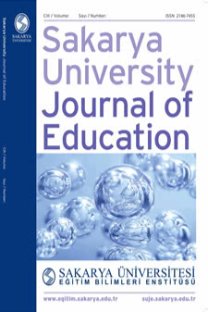Ergenler için Kısa Heyecan Arayışı Ölçeği’nin Psikometrik Özelliklerinin İncelenmesi
Bu araştırmanın amacı, Kısa Heyecan Arayışı Ölçeği’nin Türkçe versiyonunun psikometrik özelliklerinin incelenmesidir. Ölçeğin uyarlama çalışmasında öncelikle dilsel eşdeğerliğine bakılmıştır.Ölçeğin yapı geçerliği açımlayıcı faktör analizi ile incelenmiştir. Güvenirliği için ise iç tutarlılık katsayısı hesaplanmıştır. Yapılan açımlayıcı faktör analizi sonucu ölçeğin Türkçe versiyonunun orijinal yapısına uygun 4 maddeli tek faktörlü bir yapıya sahip olduğu ve güvenirlik analizinde iç tutarlılık katsayısının .81 olduğu görülmüştür. Madde analizi sonucu, ölçeğin maddelerine ilişkindüzeltilmiş madde-toplam korelasyonlarının .56 ile .68 arasında değiştiği bulunmuştur. Bu sonuçlara göre Ergenler için Kısa Heyecan Arayışı Ölçeğinin Türkçe versiyonunun geçerli ve güvenilirbir ölçme aracı olduğu söylenebilir
Anahtar Kelimeler:
Heyecan arayışı, ergen, geçerlik, güvenirlik
Psychometric Properties of Brief Sensation Seeking Scale (BSSS-4) in a Sample of Turkish Adolescents
The purpose of the current research was to investigate the psychometric properties of the BSSS-4 in Turkish sample. In this study, firstly, the relationship between Turkish and English version was examined by Pearson Product-Moment Correlation for the linguistic equivalence. Exploratory factor analysis showed that four items loaded on single-factors as the factor structure of the original scale. The present study found that the Cronbach’s Alpha coefficient of the scale is .81. These results demonstrated that the Turkish form of the Brief Sensation Seeking Scale for Adolescents is a valid and reliable instrument.
Keywords:
Sensation seeking adolescent, validity, reliability, scale adaptation,
___
- Arnett, J. J. (1999). Adolescent storm and stress, reconsidered. American Psychologist, 54, 317–326.
- Bardo, M. T., Donohew, R. L., & Harrington, N. G., (1996). Psychobiology of novelty seeking and drug seeking behavior. Behavioural Brain Research, 77, 23–43.
- Büyüköztürk, Ş. (2010). Sosyal bilimler için veri analizi el kitabı (12. Baskı). Ankara: PegemA Akademi Yayınevi.
- Byck, G. R., Swann, G., Schalet, B., Bolland, J., & Mustanski, B. (2014). Sensation Seeking Predicting Growth in Adolescent Problem Behaviors. Child Psychiatry & Human Development, 46(3), 466-473.
- Cicognani, E., & Zani, B. (2011). Alcohol use among Italian university students: The role of sensation seeking, peer group norms and self-efficacy. Journal of Alcohol and Drug Education, 55(2), 17-36.
- Curran, M. F., Fuertes, J. N., Alfonso, V. C., & Hennessy, J. J. (2010). The association of sensation seeking and impulsivity to driving while under the influence of alcohol. Journal of Addictions & Offender Counseling, 30, 84-98. doi:10.1002/j.2161-1874.2010.tb00059.x
- Çözüm, S., & Aksayan, S., (2003). Kültürlerarası ölçek uyarlaması için rehber II: Psikometrik özellikler ve kültürlerarası karşılaştırma. Hemşirelikte Araştırma Geliştirme Dergisi, 1, 3-14.
- Diehm, R., & Armatas, C. (2004). Surfing: an avenue for socially acceptable risk-taking, satisfying needs for sensation seeking and experience seeking. Personality and Individual Differences, 36, 663–677.
- Donohew, R. L., Hoyle, R. H., Clayton, R. R., Skinner, W. F., Colon, S. E., & Rice, R. E. (1999). Sensation seeking and drug use by adolescents and their friends: models for marijuana and alcohol. Journal of studies on alcohol, 60(5), 622-631.
- Donohew, L., Zimmerman, R. S., Cupp, P. S., Novak, S., Colon, S., & Abell, R. (2000). Sensation seeking, impulsive decision-making, and risky sex: implications for risk-taking and design of interventions. Personality and Individual Differences, 28, 1079–1091.
- Fekete, A. (2009). Validation of a social vulnerability index in context to river-floods in Germany. Natural Hazards and Earth System Science, 9(2), 393-403.
- Hair, J., Black, W. C., Babin, B. J., & Anderson, R. E. (2010). Multivariate data analysis (7th ed.). Upper saddle River, New Jersey: Pearson Education International.
- Hansen, E. B. & Breivik, G. (2001). Sensation seeking as a predictor of positive and negative risk behaviour among adolescents. Personality and Individual Differences, 30, 627-640.
- Hoyle, R. H., Fejfar, M. C., & Miller, J. D., (2000). Personality and sexual risk-taking: A quantitative review. Journal of Personality, 68, 1203–1231.
- Hoyle, R. H., Stephenson, M. T., Palmgreen, P., Lorch, E. P., & Donohew, R. L., (2002). Reliability and validity of a brief measure of sensation seeking. Pers. Indiv. Differences 32, 401–414.
- Kopstein, A. N., Crum, R. M., Celentano, D., & Martin, S. S. (2001). Sensation seeking needs among 8th and 11th graders: Characteristics associated with cigarette and marijuana use. Drug and Alcohol Dependence, 62, 195-203. doi:10.1016/S0376-8716(00)00170-8
- MacPherson, L., Magidson, J. F., Reynolds, E. K., Kahler, C. W., & Lejuez, C. W. (2010). Changes in sensation seeking and risk-taking propensity predict increases in alcohol use among early adolescents. Alcoholism, Clinical and Experimental Research, 34(8), 1400-1408.
- Manna, G., Faraci, P., & Como, M. R. (2013). Factorial Structure and Psychometric Properties of the Sensation Seeking Scale – Form V (SSS-V) in a Sample of Italian Adolescents. Europe's Journal of Psychology, 9(2), 276–288. doi:10.5964/ejop.v9i2.500
- Spahi, B. Yurtkoru, E. S., & Çinko, M. (2008). Sosyal bilimlerde SPSS’le veri analizi. İstanbul: Beta Basım Yayım Dağıtım.
- Steinberg, L. (2008). A social neuroscience perspective on adolescent risk-taking. Developmental review, 28(1), 78-106.
- Stephenson, M. T., Hoyle, R. H., Palmgreen, P., & Slater, M. D. (2003). Brief measures of sensation seeking for screening and large-scale surveys. Drug and Alcohol Dependence, 72(3), 279–286.
- Vallone, D., Allen, J. A., Clayton, R. R., & Xiao, H. (2007). How reliable and valid is the Brief Sensation Seeking Scale (BSSS‐4) for youth of various racial/ethnic groups?. Addiction, 102(s2), 71-78. doi: 10.1111/j.1360-0443.2007.01957.x
- ISSN: 2146-7455
- Yayın Aralığı: Yılda 3 Sayı
- Başlangıç: 2011
- Yayıncı: Sakarya Üniversitesi Eğitim Bilimleri Enstitüsü
Sayıdaki Diğer Makaleler
Psychometric Properties of Brief Sensation Seeking Scale (BSSS-4) in a Sample of Turkish Adolescents
Algılanan Öz-Düzenleme Ölçeği'nin Geliştirilmesi:Geçerlik ve Güvenirlik Çalışması
Adem PEKER, Yüksel EROĞLU, Neslihan ÖZCAN
Algılanan Öz-Düzenleme Ölçeği: Bir Ölçek Geliştirme Çalışması
Adem PEKER, Yüksel EROĞLU, Neslihan ÖZCAN ARICI
Yönetim Kuramları Bakımından Günümüz Okul Yöneticilerinin Yönetim Anlayışları
Mehmet Ali HAMEDOĞLU, Ebru ÖZDEN
Kitap İncelemesi: Öğretmen Olmak
İlkokul 2. Sınıf Öğrencilerinin Okuduğunu Anlama Becerilerinin Cinsiyet ve Yaşa Göre İncelenmesi
Esra CERAN, Miray OĞUZGİRAY YILDIZ, İlke ÖZDEMİR
Küresel Sosyal Sorumluluk Ölçeği: Geçerlik ve Güvenirlik Çalışması
